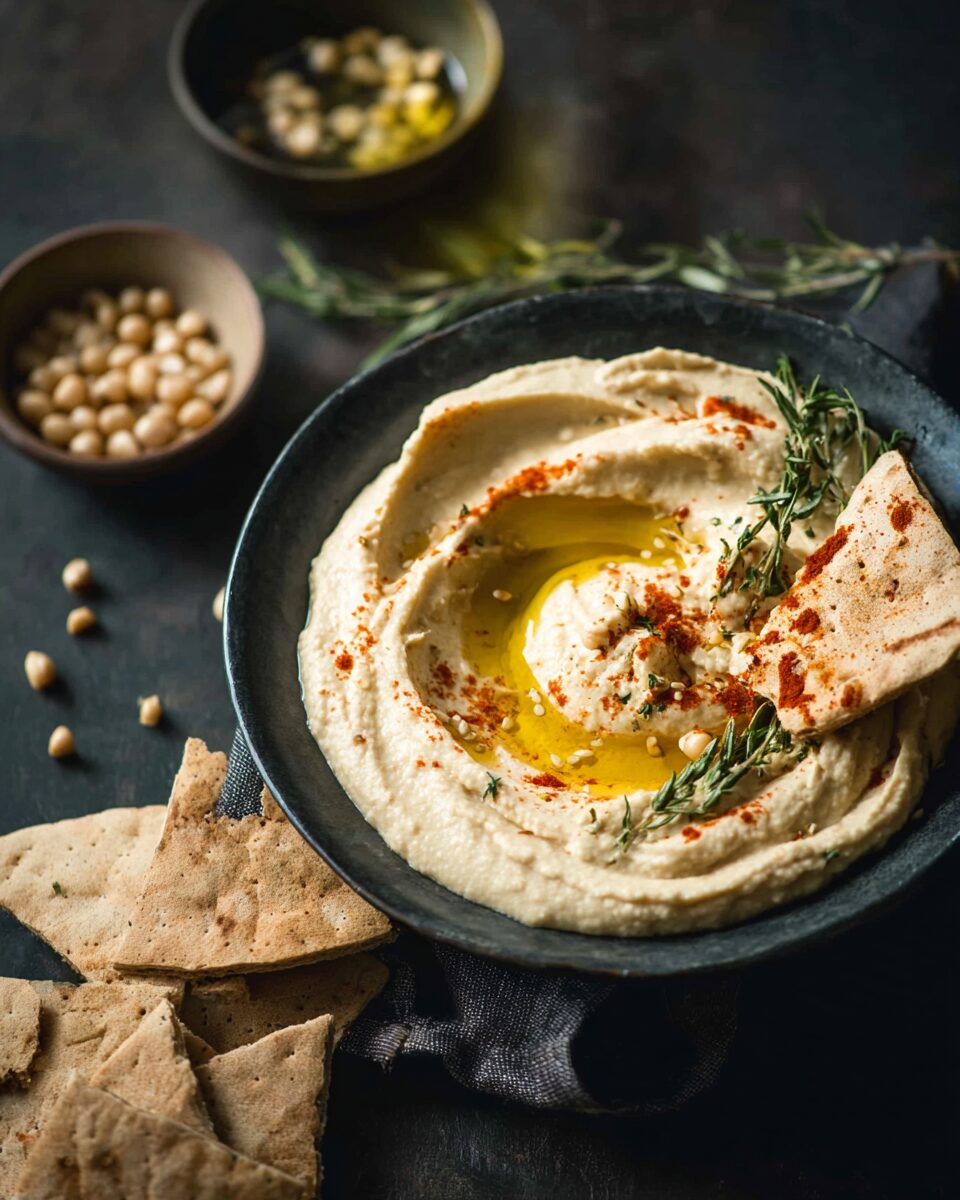Hummus is the ultimate creamy dip made with simple ingredients but delivers a rich and savory taste that’s perfect for any occasion. Whether served with warm pita bread, crunchy veggies, or used as a sandwich spread, this creamy dip will never disappoint.
Its smooth, velvety texture combined with the earthiness of tahini and the fresh zing of lemon makes this hummus an irresistible treat for both casual snacking and elegant entertaining. The best part is, it’s incredibly versatile and can be customized to your liking with the addition of roasted garlic, extra spices, or even some chopped olives for an added twist.
Full Recipe:
-
1 can (400g) chickpeas, drained and rinsed
-
1/4 cup tahini
-
2 tablespoons olive oil, plus extra for serving
-
2 tablespoons lemon juice
-
1 garlic clove, minced
-
1/2 teaspoon ground cumin
-
Salt to taste
-
Water, as needed
-
Fresh parsley, for garnish
Directions:
-
Combine chickpeas, tahini, olive oil, lemon juice, garlic, cumin, and a pinch of salt in a food processor.
-
Blend until smooth. If the mixture is too thick, gradually add water, one tablespoon at a time, until desired consistency is reached.
-
Taste and adjust seasoning as needed.
-
Transfer the hummus to a bowl, drizzle with olive oil, and garnish with fresh parsley.
-
Serve with pita bread, vegetables, or as a dip for your favorite snacks.
Prep Time: 10 minutes | Cooking Time: 0 minutes | Total Time: 10 minutes
Kcal: 180 kcal | Servings: 6 servings
History of Hummus
Hummus is a beloved dish that has been around for centuries. Its origins are often debated, with both Lebanon and Israel claiming to be the birthplace of this savory spread. Despite the ongoing debate, one thing is clear: hummus has deep roots in the Middle Eastern and Mediterranean regions, where it has been enjoyed for centuries. The word “hummus” comes from the Arabic word for chickpeas, the main ingredient in the dish. Hummus, in its most basic form, is made by blending chickpeas with tahini, lemon juice, garlic, and olive oil, resulting in a smooth, creamy dip or spread.
Over time, hummus has evolved and spread globally, becoming a staple in many cuisines, especially among vegetarian and vegan communities. Its simplicity, health benefits, and versatility have contributed to its widespread popularity. Today, hummus is enjoyed in numerous ways, from a dip to a sandwich spread and even as a salad dressing.
Variations of Hummus
While the traditional recipe is simple, there are countless variations of hummus across the world. One of the most common variations is the addition of roasted garlic, which gives the hummus a deeper, richer flavor. Another popular twist is the inclusion of roasted red peppers, which add a slight sweetness and vibrant color to the dip. Some people also like to spice up their hummus by adding cumin, paprika, or chili flakes, which bring a bit of heat and complexity.
For those who prefer a sweeter version of hummus, some recipes incorporate ingredients like beets or carrots, creating a colorful and subtly sweet dip. Another common variation includes adding herbs like cilantro or parsley for a fresh, green flavor. There are even dessert versions of hummus, such as chocolate hummus, where chickpeas are blended with cocoa powder, vanilla, and sweeteners to create a unique and healthy treat.
With so many variations, hummus can easily be adapted to suit any taste preference or dietary need. Whether you like your hummus spicy, tangy, or sweet, there’s a variation for everyone.
Uses of Hummus
Hummus is incredibly versatile and can be used in a variety of ways. Traditionally, it is served as a dip, often paired with pita bread, fresh vegetables, or crackers. It can be served as part of a mezze platter, alongside other small appetizers like tabbouleh, baba ganoush, and falafel. Hummus also makes a great topping for salads or grain bowls, adding a creamy texture and a dose of flavor.
In addition to its role as a dip, hummus is frequently used as a spread for sandwiches and wraps. It works beautifully as a base for a veggie wrap, adding richness and depth. You can also use hummus as a spread for toast, topped with avocado and a sprinkle of herbs for a nutritious breakfast or snack.
Another way to incorporate hummus into your meals is by using it as a base for savory dishes. You can drizzle it over roasted vegetables, serve it with grilled meats, or even mix it into pasta for a creamy sauce. The possibilities are endless when it comes to incorporating hummus into your diet.
Nutritional Benefits of Hummus
One of the main reasons hummus has gained popularity is due to its numerous health benefits. As a plant-based dish, hummus is rich in protein, fiber, and healthy fats, making it an excellent choice for vegetarians, vegans, and anyone looking to boost their nutrient intake. Chickpeas, the primary ingredient in hummus, are an excellent source of plant-based protein, which is essential for muscle building and repair.
Hummus also provides a healthy dose of fiber, which is important for digestive health. The fiber in hummus can help regulate bowel movements, prevent constipation, and support a healthy gut microbiome. In addition to fiber and protein, hummus contains healthy fats from tahini and olive oil, both of which are heart-healthy and can help reduce inflammation.
For those watching their blood sugar, hummus is a great option because it has a low glycemic index, meaning it won’t cause a rapid spike in blood sugar levels. This makes it an ideal choice for people with diabetes or anyone looking to maintain stable blood sugar levels. Additionally, hummus is packed with vitamins and minerals, including folate, iron, magnesium, and potassium, which are all important for overall health.
How to Make Hummus at Home
Making hummus at home is incredibly simple and requires only a few basic ingredients. All you need is a food processor or blender to blend the chickpeas, tahini, lemon juice, garlic, olive oil, and any additional seasonings or flavorings you like. Homemade hummus is often fresher and more flavorful than store-bought versions, and you can customize it to your taste.
To make hummus extra smooth, some people prefer to peel the skins off the chickpeas before blending. While this step is not necessary, it can help create a silkier texture. You can also adjust the amount of water or olive oil to get the consistency you prefer. For a thicker hummus, use less water, and for a creamier dip, add a bit more.
Hummus in Different Cultures
Hummus holds a special place in the cuisine of many cultures, particularly in the Middle East and Mediterranean. It is often a key component of a mezze platter, where it is served alongside other dips, salads, and small dishes. In Israel, hummus is considered a national dish and is often eaten as part of breakfast, with fresh pita bread and toppings like olives, vegetables, or hard-boiled eggs.
In Lebanon, hummus is typically served with a drizzle of olive oil, a sprinkle of parsley, and a few whole chickpeas on top. The dish is often accompanied by a side of pickled vegetables, such as cucumbers or turnips. In Syria and Jordan, hummus is also commonly eaten with flatbread and a variety of other meze items.
Beyond the Middle East, hummus has become increasingly popular in Western countries, where it is enjoyed as a healthy snack or appetizer. It is now widely available in supermarkets and has even found its way into fast food restaurants as a dipping option for fries or pita chips.
Conclusion
Hummus is more than just a tasty dip; it is a versatile and nutritious food that has earned its place in kitchens around the world. With its rich history, numerous variations, and health benefits, it’s no wonder that hummus has become a staple in many diets. Whether you enjoy it as a dip, spread, or main dish, hummus is a delicious and satisfying addition to any meal.
Its versatility makes it an easy and enjoyable choice for both casual snacking and formal gatherings. As more people discover the many ways to enjoy hummus, it continues to grow in popularity and is sure to remain a favorite for years to come. So, whether you’re enjoying a classic hummus recipe or experimenting with new flavors, you can be sure that this dish will always deliver both flavor and nourishment.





